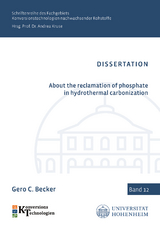About the reclamation of phosphate in hydrothermal carbonization
Seiten
Within this dissertation, the development of a phosphate reclamation process, based on hydrothermal Carbonisation (HTC) is introduced, examined, and improved. The proof of principle includes hydrothermal carbonization of sewage sludge, the separation of process water, acid leaching of the residual solid product (hydrochar) to solve bound phosphate, and the directed precipitation of a mineral fertilizer from the mixed liquid phases. The acid leaching of the hydrochar is necessary, as HTC effectively transforms the different forms of organic and inorganic phosphate to more homogenous, but less water-soluble inorganic forms, fixed in the hydrochar. Thermodynamic calculations for possible salt formation at an equilibrium state give deeper insights in the compounds that can be expected, and that might be accessible to acid leaching. These calculations are a valuable tool for the further process development, but the validation of these results require a combination of other analytical techniques.
A quite common technique is the application of sequential extraction schemes to distinguish between different phosphate forms (speciations), but the discussion and interpretation of these techniques is very case specific. This discussion in depth is provided within this dissertation by the comparison of different extraction schemes and methods. By introducing and evaluating also fast and slow pyrolysis, as a comparable high temperature process to treat and transform sewage sludge to a char like material, the advantages of HTC are revealed in higher possible phosphate recovery rates and therefore better reclamation.
A quite common technique is the application of sequential extraction schemes to distinguish between different phosphate forms (speciations), but the discussion and interpretation of these techniques is very case specific. This discussion in depth is provided within this dissertation by the comparison of different extraction schemes and methods. By introducing and evaluating also fast and slow pyrolysis, as a comparable high temperature process to treat and transform sewage sludge to a char like material, the advantages of HTC are revealed in higher possible phosphate recovery rates and therefore better reclamation.
| Erscheinungsdatum | 05.10.2024 |
|---|---|
| Reihe/Serie | Schriftenreihe des Fachgebiets Konversionstechnologien nachwachsender Rohstoffe ; 12 |
| Verlagsort | Düren |
| Sprache | englisch |
| Maße | 148 x 210 mm |
| Gewicht | 157 g |
| Themenwelt | Weitere Fachgebiete ► Land- / Forstwirtschaft / Fischerei |
| Schlagworte | hydrothermal Carbonisation (HTC) • phosphate reclamation process • struvite |
| ISBN-10 | 3-8440-9609-4 / 3844096094 |
| ISBN-13 | 978-3-8440-9609-5 / 9783844096095 |
| Zustand | Neuware |
| Informationen gemäß Produktsicherheitsverordnung (GPSR) | |
| Haben Sie eine Frage zum Produkt? |
Mehr entdecken
aus dem Bereich
aus dem Bereich
Buch | Hardcover (2023)
DLG-Verlag
CHF 109,95
Buch | Hardcover (2023)
Haymarket Media (Verlag)
CHF 44,50




